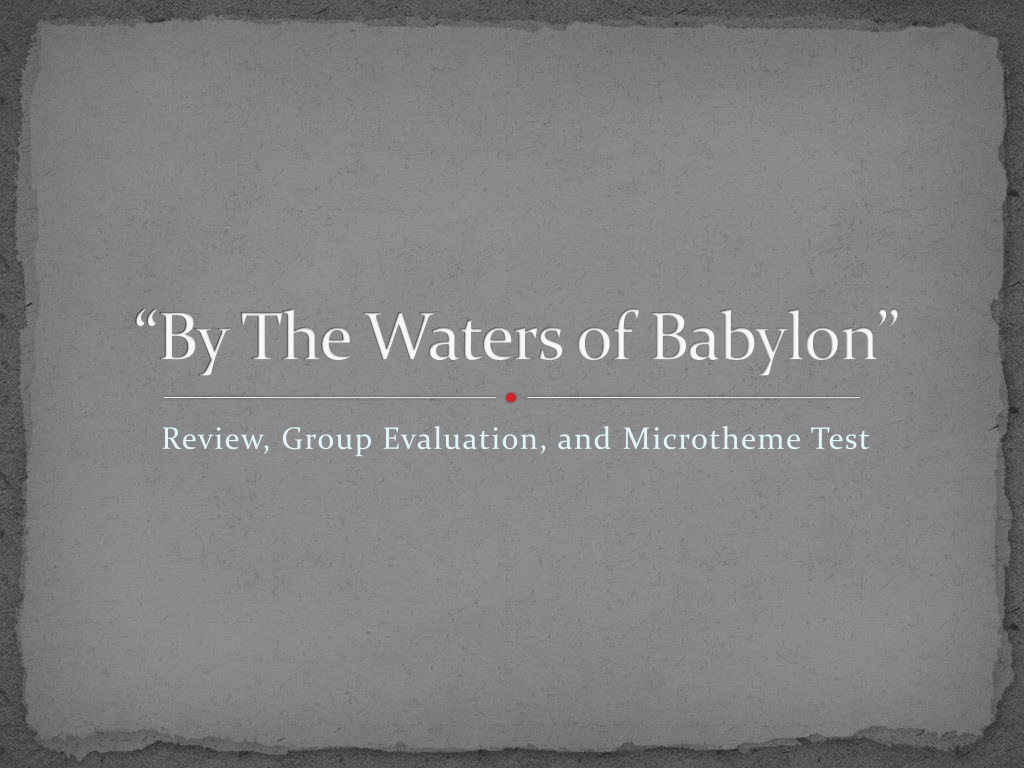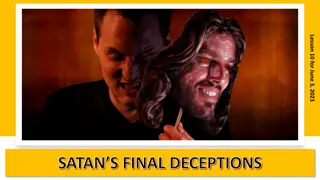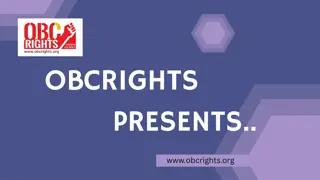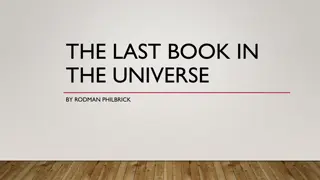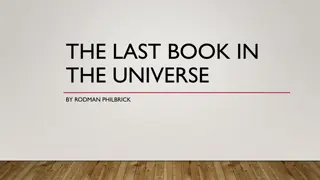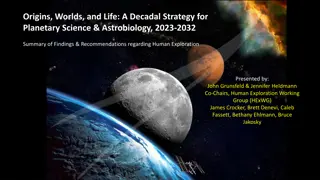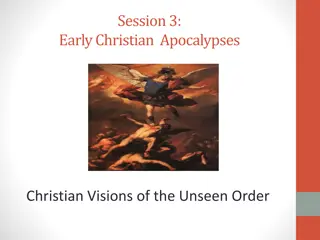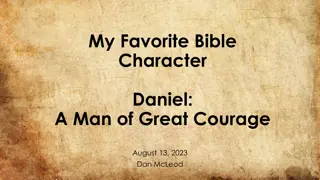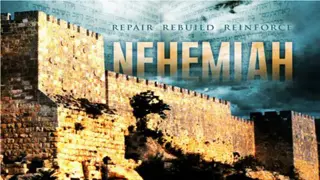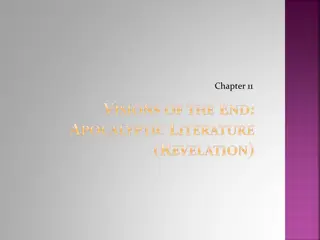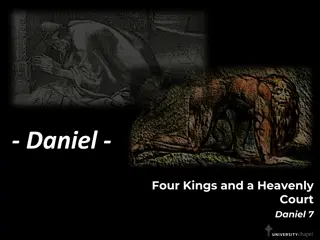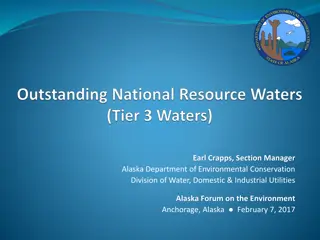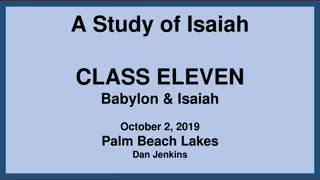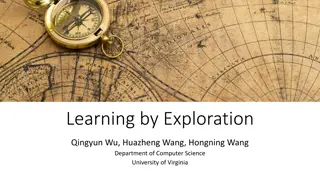Exploration of a Post-Apocalyptic World in "By the Waters of Babylon
In "By the Waters of Babylon," the narrator, a son of a priest, embarks on a journey to the Dead Places, revealing a world destroyed by a cataclysmic event. Through his first-person account, readers witness his encounters with remnants of a lost civilization, his awakening to the truth behind the gods, and his vow to rebuild. The story's setting depicts a primitive society that reveres the past, yet the narrative voice uncovers deeper truths about the world's transformation after the Great Burning.
Download Presentation

Please find below an Image/Link to download the presentation.
The content on the website is provided AS IS for your information and personal use only. It may not be sold, licensed, or shared on other websites without obtaining consent from the author. Download presentation by click this link. If you encounter any issues during the download, it is possible that the publisher has removed the file from their server.
E N D
Presentation Transcript
By The Waters of Babylon Review, Group Evaluation, and Microtheme Test
What is the story about? The narrator is the son of a priest, and he visits the Dead Places with his father to collect metal. Only priests and sons can go to these places. When he gets older, he tells his father he must go on a journey. His father approves and oversees a purification ceremony for his son. During the ceremony the narrator tells his dream of the Dead Place and the gods.
He goes on his journey, crosses a river on a raft, and enters the Place of the Gods, a great city of tall buildings all in ruins. He is chased by dogs that do not fear him, and escapes into a tall building, where he stays for the night. He is amazed at the mysterious things he finds. During the night, he feels the spirit is of the gods drawing him out of his body and he sees the city when it was still alive, filled with lights, chariots, and people.
Then he witnesses the destruction of the city in the Great Burning. The next morning he finds the body of the god who lives in the place where he slept. He realizes that the god was a man. The narrator then returns home. His father acknowledges his son s achievement and observes that the truth must come out little by little. The narrator promises that when he is the chief priest, he will take his people to the Place of the Gods to begin building again.
Question 1: This is an overview What is the effect of telling the story in 1stperson point of view? We know only what the narrator knows, which allows the reader to truly recognize how the world has changed from the Great Burning and why the Place of the Gods is not what it was before.
Question 2: This is an overview What conclusions can you draw so far about the setting of the story? Future, Earth, has to have taken place after something cataclysmic has taken place the world is not the way we know it The people are primitive, superstitious, and collect metal from ruins (from what appears to be an advanced civilization). They find books that they do not understand either.
Question 3: This is an overview Simple sentences allow: The character to be understood to be: innocent, unsophisticated, but slightly educated. The way he talks to the reader mimics how a person might speak and think.
Question 4: This is an overview Conflict: INTERNAL. He is afraid to visit the Place of the Gods. Conflict: EXTERNAL If this world was destroyed, what could harm him? It s the unknown.
Question 5: This is an overview Great Burning: the destruction of the city and of civilization (nuclear warfare, etc.) Bitter Water: the river Place of the Gods: New York City
Question 6: This is an overview My skin ready for danger : His skin is prickling as sometimes it happens when we feel fear.
Question 7: This is an overview The statue represents George Washington How could you have known this? Clues! Long hair that was tied back The inscription has half of his name
Question 8: This is an overview The dog is to add a sense of realism. The dogs have learned how to survive independently (like wolves!) without humans, and may not have ever seen a human. The dog reverted to his wild side and is now a predator. They would have no reason to fear a human, and would consider them a form of prey.
Question 9: This is an overview The long-small chamber is a hallway. The bronze door is an elevator door. It doesn t open but it gives you an idea of the technology that was available.
Question 10: This is an overview This is an opinion question that the group should have answered! The answer varies, but it might be uneasiness or fear.
Question 11: This is an overview The city was destroyed in the Great Burning. A weapon of mass destruction (nuclear weapon) caused the city to die. War unlike any known to the narrator s world Came from the sky (a rocket) A mist poisoned the city (a fallout) Remained toxic (nuclear poisoning)
Question 12: This is an overview The title question: It occurs beside a large river and tells the destruction of a great civilization and of the narrator s sorry at the loss of all the knowledge and brilliance of that dead society. Babylon is a world that represents lost societies. There is a real city from 1894 BC that was lost but the foundations still exist today. From the foot of Saddam Hussein's Summer Palace a Humvee is seen driving down a road towards the left. Palm trees grow near the road and the ruins of Babylon can be seen in the background.
Question 13: This is an overview Another opinion question
MicrothemeTest: You are going to need: The instructions from last week. We do NOT have extra copies! You may have to write more down than your peers if you lost your paper! A pen/pencil.
Step One: ANNOTATE Circle words that have a strong emotional appeal (aka: connotation). In the margin: how does this word impact the reader? Explain. We shall go to the Place of the Gods the place newyork not one man but a company. We shall look for the images of the gods and find the god ASHING and the others the gods Lincoln and Biltmore and Moses. But they were men who built this city, not gods or demons. They were men who were here before us. We must build again (Benet 272).
Step Two: ANSWER THIS QUESTION In the white space on your worksheet, answer the question: WHAT IS BENET S NARRATOR SAYING ABOUT THE NEED TO REBUILD AND TO KNOW THE TRUTH ABOUT WHAT HAPPENS?
Your Prompt Using the selected text provided, what is Benet s goal in writing By the Waters of Babylon ? Analyze the narrator and how the narrator s journey helps to prove a point. Hints to success: You should reference the provided quote at least once in your microtheme. It says so in the prompt. Hints to success: You should focus on the narrator mostly. How does the narrator establish the need to rebuild?
MLA Practice Set up your paper JUST LIKE THIS. Always, always, always!
A Few Guidelines Format: I: Thesis Statement II: Body Paragraph III: Concluding Statement Voice: You cannot use first person. Or second person.
I. Thesis Statement: In Stephen Vincent Benet s short story, By the Waters of Babylon, the narrator _________________________ ______________________________________________. Fill in the blanks by answering: What does the narrator help to show with Benet s goal? Look at what you said Benet s goal was. INTEGRATE your response here to include how the narrator helps to develop this.
Need help? Fill in the blanks by answering: What does the narrator help to show with Benet s goal? Possible ideas include focusing on: How journey s sometime reveal the truth that was unknown How easy it is to forget what once was when we are busy trying to survive How one man can change the future I: In Stephen Vincent Benet s short story, By the Waters of Babylon, the narrator __________________ ______________________________________________.
Check out my example I. Thesis Statement: In Stephen Vincent Benet s short story By the Waters of Babylon , the narrator helps to establish that knowledge and truth are what impacts the future the most.
II. Body Paragraph This is NINE sentences. In essay s, it is ELEVEN sentences you ll have a topic sentence and concluding sentence! Concrete Detail (CD): You ll have THREE sentences all three with a parenthetical documentation. Commentary (CM): You ll have SIX sentences.
II. Body Paragraph Start with a concrete detail about the narrator. A concrete detail should: Link to your thesis statement Have less than 10 words from the author Have a lead-in, and a parenthetical citation
Look at this example Benet s narrator goes into the Place of the Benet s narrator goes into the Place of the Gods where he shows his fear of the city Gods where he shows his fear of the city by keeping his voice still (266). by keeping his voice still (266). This shows the role of the narrator to be a protagonist who struggles from an internal conflict. By doing this, Benet is able to show how important knowledge is; ultimately, this is significant because the protagonist is able to overcome his fear when he knows the truth.
Concrete Detail Possibilities: Narrator After going to the Place of the Dead: I looked at the bones in the shadow and kept my voice still (Benet 266). What type of character is he? What WORDS would you use to describe the INTERNAL CONFLICT that he is experiencing? On his way to New York: There was no strength in my knowledge anymore and I felt small and naked as a new-hatched bird alone upon the great river, the servant of the Gods (Benet 268). He s changed. How? Explain how this shows he is a DYNAMIC CHARACTER. What words/phrases would work to discuss a METAPHOR. How does the metaphor make a good point?
Commentary Sentence 1 will always answer the question: What does this prove in relation to your thesis statement? Essentially, without saying I chose this quote because, explain why this quote relates to your thesis statement. Sentence 2 will always answer the question: Why is this significant to the story as a whole? Does it help support another element? Identify another element that is in play. Does it make a greater point? Can you link this to Benet s goal?
II. Body Paragraph Start with a concrete detail about the setting. A concrete detail should: Link to your thesis statement Have less than 10 words from the author Have a lead-in, and a parenthetical citation
Concrete Detail Possibilities: Setting Observing New York: The towers were high enough, but not so high, and while many of the dead houses were wrecked, there were some that stood (Benet 269). What is the purpose to the IMAGERY here? What is being established with the high towers? During the time where spirits showed them what happened to them: The sky itself was alight you could barely see the stars for the glow in the sky (Benet 271). The narrator describes the way it once was he s using context clues to pinpoint you to a city. Why? Think about how this could establish a point to the reader?
Commentary Sentence 1 will always answer the question: What does this prove in relation to your thesis statement? Essentially, without saying I chose this quote because, explain why this quote relates to your thesis statement. Sentence 2 will always answer the question: Why is this significant to the story as a whole? Does it help support another element? Identify another element that is in play. Does it make a greater point? Can you link this to Benet s goal?
II. Body Paragraph Start with a concrete detail about the conflict. A concrete detail should: Link to your thesis statement Have less than 10 words from the author Have a lead-in, and a parenthetical citation
Concrete Detail Possibilities: Conflict After learning the truth: This I all of my story, for then I knew he was a man I knew then that they had been men, neither gods nor demons. It is a great knowledge, hard to tell and believe (Benet 272). He finishes his tale. What is the internal conflict being hinted at? What does he WANT to accomplish on his return home? His last statements: We shall go to the Place of the Gods the place newyork not one man but a company. We shall look for the images of the gods and find the god ASHING and the others the gods Lincoln and Biltmore and Moses. But they were men who built this city, not gods or demons. They were men who were here before us. We must build again (Benet 272). What is the EXTERNAL conflict? How does it link to Benet s goal? Think big idea
Commentary Sentence 1 will always answer the question: What does this prove in relation to your thesis statement? Essentially, without saying I chose this quote because, explain why this quote relates to your thesis statement. Sentence 2 will always answer the question: Why is this significant to the story as a whole? Does it help support another element? Identify another element that is in play. Does it make a greater point? Can you link this to Benet s goal?
III. Concluding Sentence Make an analogy to show how the lesson of this story applies to today! If his goal is to think about how we are to rebuild WHILE we survive, what can we think of in time in which people were forced to do this? Holocaust survivors: Even after liberation, many still died. They had no money, no place to go. Pearl Harbor: we had to rebuild an army and war materials. Tsutomu Yamaguchi: 93-year-old man who survived both atomic bombings (died from stomach cancer) http://www.cnn.com/2010/WORLD/asiapcf/01/06/japan.bomb.v ictim.dies/index.html
Double Check Your Title Is it done? Is it creative?
Submit Your Work! Now, understand THIS is what you ll be doing on your ESSAY to conclude this unit. Notable differences: Four paragraphs (intro, 2 body paragraphs, conclusion) Body paragraphs will have 11 sentences Different story This is a difficult skill. It takes time. You CANNOT rush this assignment.
Group Evaluation: KEEP YOUR EYES ON YOUR PAPER On the bottom of your microtheme, write the name of your group members. On a scale of 1-10, what would you give your group members? 1 = They were not helpful. 5 = They were somewhat helpful. 10 = They were awesome! Next to your ranking, tell me what each group member accomplished.
